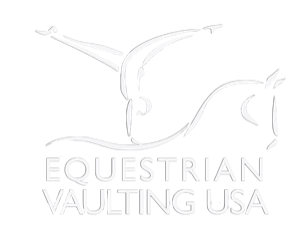Horse Welfare
Horse Welfare

Photo courtesy Andrea Selch
In any equestrian sport, first priority must be given to the well being of the horse, for without the horse nothing can be accomplished. Anyone who has the responsibility for a horse’s care should learn as much as possible about how to keep the horse in top condition both physically and mentally, and they should learn how to identify problems if they should appear. Overall sensitivity to your horse’s well being can help you and your horse enjoy a long, safe and pleasant career in vaulting.
Special considerations must also be given to the vaulting horse due to his unique job and performance requirements. For example, be sure to work your horses equally in both directions. Many clubs warm up and cool down the horse to the right since much of their work is done to the left. Additionally, work the horse under saddle to maintain its physical condition and keep the horse’s mental attitude fresh. Use proper vaulting pads of high quality materials to protect your horse’s back. Wrap your horse’s legs to both protect from impact as well as offer support. Train your horse under saddle and without vaulters to build up strength beforehand. Finally, give your horse adequate time off each week and after strenuous workouts and competitions.
Basic horse care must include regular vaccinations, deworming, hoof care and veterinarian health checks, daily grooming and hoof cleaning, regular exercise, good nutrition and constant access to clean water, and daily cleaning of living area.
Code of Conduct for the Welfare of the Horse
Everyone involved in the sport of vaulting is required to adhere to EVUSA’s Code of Conduct for the welfare of the horse and to acknowledge and accept that at all times the welfare of the horse is paramount and must never be subordinated to competitive or commercial influences.
At all stages during the preparation and training of competition horses, welfare must take precedence over all other demands.
- Good horse management: stabling, feeding and training must be compatible with good horse management and must not compromise welfare. Any practices which could cause physical or mental suffering, in or out of competition, will not be tolerated.
- Training methods: horses must only undergo training that matches their physical capabilities and level of maturity for their respective discipline. They must not be subjected to any training methods which are abusive or cause fear or for which they have not been properly prepared.
- Farrier and tack: hoof care and shoeing must be of a high standard. Tack must be designed and fitted to avoid the risk of pain or injury.
- Transport: during transportation, horses must be fully protected against injuries and other health risks. Transportation must be safe, well ventilated, maintained to a high standard, disinfected regularly and driven by competent staff. Competent handlers must always be available to manage the horses.
- Transit: all journeys must be planned carefully, and horses allowed regular rest periods with access to food and water on longer journeys.

Photo courtesy Andrea Selch
Horses and athletes must be fit, competent and in good health before they are allowed to compete.
- Fitness and competence: participation in competition must be restricted to fit horses and athletes of proven competence.
- Health status: no horse showing symptoms of disease, lameness or other significant ailments or pre-existing clinical conditions should compete or continue to compete when to do so would compromise its welfare. Veterinary advice must be sought whenever there is any doubt.
- Doping and Medication: abuse of doping and medication is a serious welfare issue and will not be tolerated. After any veterinary treatment, sufficient time must be allowed for full recovery before competition.
- Surgical procedures: any surgical procedures that threaten a competing horse’s welfare or the safety of other horses and/or athletes must not be allowed.
- Pregnant/recently foaled mares: mares must not compete after their fourth month of pregnancy or with foal at foot.
- Misuse of aids: abuse of a horse using natural riding aids or artificial aids (e.g. whips, spurs, etc.) will not be tolerated.
Events must not prejudice horse welfare.
- Competition areas: horses must only be trained and compete on suitable and safe surfaces. All obstacles must be designed with the safety of the horse in mind.
- Ground surfaces: all ground surfaces on which horses walk, train or compete must be designed and maintained to reduce factors that could lead to injuries. Particular attention must be paid to the preparation, composition and upkeep of surfaces.
- Extreme weather: competitions must not take place in extreme weather conditions if the welfare or safety of the horse may be compromised. Provision must be made for cooling horses after competing.
- Stabling at events: stables must be safe, hygienic, comfortable, well ventilated and of sufficient size for the type and disposition of the horse. Clean, good quality and appropriate feed and bedding, fresh drinking water, and washing-down water must always be available.
- Fitness to travel: after competition, a horse must be fit to travel in accordance with EVUSA’s guidelines.
Every effort must be made to ensure that horses receive proper attention after they have competed and that they are treated humanely when their competition careers are over. EVUSA urges all those involved in equestrian sport to attain the highest possible levels of education in their areas of expertise relevant to the care and management of the competition horse.
This page may be modified from time to time and the views of all are welcomed. A warning card may be issued by a licensed official, at which point said infraction would be brought before a closed session of the EVUSA board of Directors.
The Code of Conduct is in place so that judges, lungers, vaulters and coaches have an understanding of quality safety and care of the horses. The code of conduct was drawn with permission from the FEI guidelines for vaulting.
